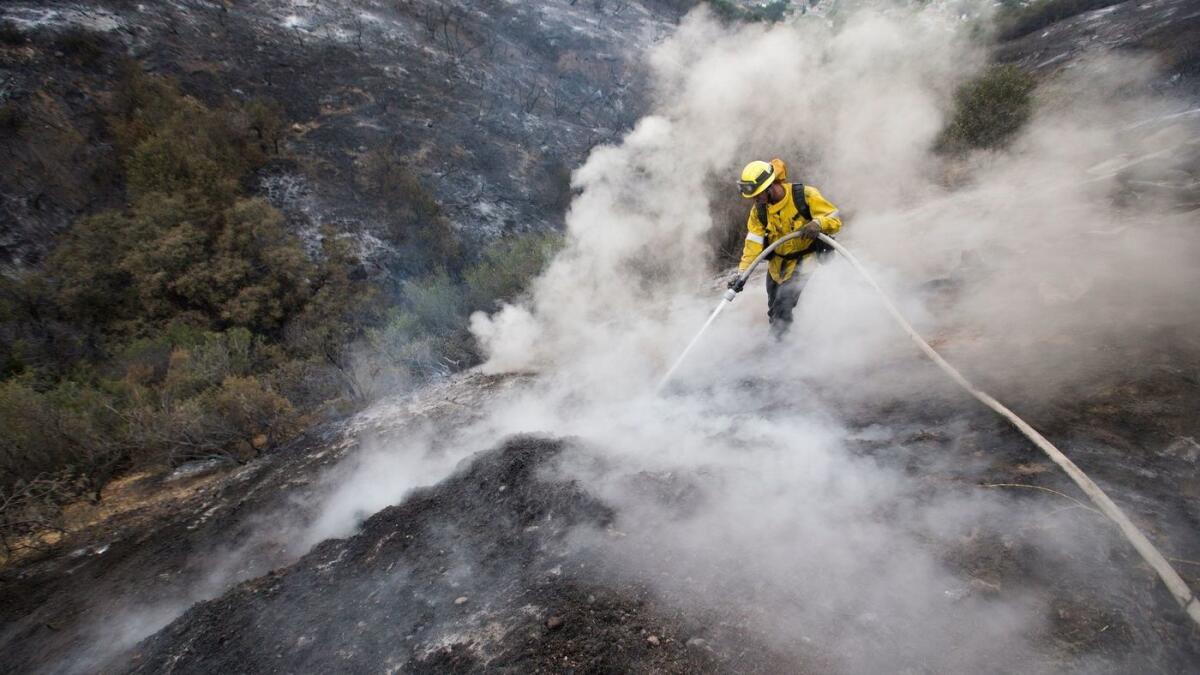Op-Ed: Lessons from the La Tuna fire

- Share via
Driven by triple-digit temperatures and high winds, the La Tuna fire scorched 7,194 acres of shrubland and forest in the western Verdugo Mountains area of Los Angeles, Glendale and Burbank last summer, making it the largest fire to occur within Los Angeles city limits in half a century. What made the La Tuna fire truly remarkable was not its size, however, but the lessons it provided for our changing fire season, which seems to begin earlier and end later every year.
By the time the fire was out, there were nearly 1,400 homes either within the fire perimeter or within 200 feet of its path, yet only five homes were destroyed in the fire. How is this possible?
Los Angeles is a national leader in encouraging, and enforcing, fire-safe principles for homes. Angelenos are used to annual inspections and notices about “defensible space” — the practice of reducing combustible grasses, shrubs and small trees within 100 feet of homes each spring. If people do not get around to the task, city workers will simply do it for them, and the homeowners get the bill. Moreover, the city constantly updates building codes as new information arises about how to make homes more fireproof.
Home protection must begin long before a fire does.
While more than 99% of the homes survived the La Tuna fire, there were a few that did not. These were in remote areas that escaped annual monitoring for defensible space, or had not been updated with ember-proof vents, which prevent firebrands from being driven into attic spaces by high winds.
That is to say: The system works, so long as we let it work. Home protection must begin long before a fire does.
Despite the evidence, many policymakers still mistakenly believe that wildland fires behave unpredictably, and that their effect on homes is similarly unpredictable. That leads to inaction.
More troubling, some politicians are now attempting to use the loss of homes and lives in recent wildland fires as an excuse to reduce environmental protections and increase commercial logging in our national forests under the guise of “thinning.” President Trump backed this disastrous approach in a recent series of tweets.
Enter the Fray: First takes on the news of the minute from L.A. Times Opinion »
The truth is that vegetation management activities beyond 100 feet from individual homes provides no additional protection from wildfires. But Trump’s two-pronged strategy—less protection, more logging— is worse than pointless: It has been proven to increase a fire’s intensity and spread. And as if that weren’t bad enough, it will also give rural residents a false sense of security.
The way forward is simple, based on solid science and makes common sense. We must focus on the 100-foot perimeter around homes, create better fire-warning and evacuation infrastructures, and increase the number of rangers and law enforcement deployed to prevent human ignitions near communities.
If we take these steps, and prioritize them in our funding and policymaking decisions, we can coexist with fire, which is a natural part of most ecosystems. If, however, we allow cynical or misinformed politicians to use recent tragedies as an excuse to enrich the logging industry, that will not only imperil wildlife populations with habitat loss, but also virtually guarantee more large-scale losses of homes and lives in the future.
Chad Hanson is a forest and fire ecologist with the John Muir Project. He is the co-editor and co-author of the book, “The Ecological Importance of Mixed-Severity Fires: Nature’s Phoenix.”
Follow the Opinion section on Twitter @latimesopinion or Facebook
More to Read
A cure for the common opinion
Get thought-provoking perspectives with our weekly newsletter.
You may occasionally receive promotional content from the Los Angeles Times.









